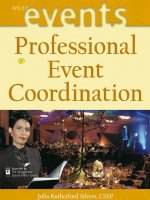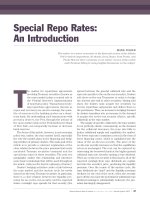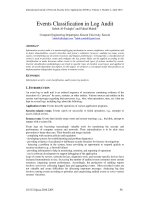Special events 7th ch08
Bạn đang xem bản rút gọn của tài liệu. Xem và tải ngay bản đầy đủ của tài liệu tại đây (3.37 MB, 36 trang )
Special Events, 7 Edition
th
Creating, Sustaining, and
Celebrating a New World
Professor Joe Goldblatt, FRSA
Chapter Eight:
Risk Management: Health and
Safety, Legal, and Ethical
Safeguards
Copyright © 2014 by John Wiley & Sons, Inc. All rights
CHAPTER 8
AGENDA
Copyright © 2014 by John Wiley & Sons, Inc. All rights
Photo by the Author.
Agenda
1.
2.
3.
4.
5.
6.
7.
Animated introduction
Opening Activity:
Chapter Seven Review
Chapter Eight
Book Report Chapter Eight
Mini case study discussion sixteen
Global event thought leader Martin van
Keken
8. Assignments
9. Questions, answers, and discussion
Copyright © 2014 by John Wiley & Sons, Inc. All rights
Key Terms
•
•
•
•
Corporate social responsibility (CSR): The strategic process
through which the event organization determines how each event
may build social and environmental capital and produce positive
social, economic, and environmental impacts.
Ethics: The gray areas that too often result in problems for event
planners and their organization’s reputation due to poor planning
and decisions. Ethics may inform laws but are not always subject
to legal tests. However, they must be carefully considered to build
a positive reputation for the event planner.
Health and safety: The requirement that event planners meet
the standard of care customarily associated with provided a
healthy and safe outcome with every special event.
Risk Management: Identifying, assessing, analyzing, planning,
managing and controlling the typical risks associated with your
event.
Copyright © 2014 by John Wiley & Sons, Inc. All rights
Lecture Seven Review
1.
2.
3.
4.
Conduct event-marketing research
Develop an integrated marketing program
Use the five Ps of event marketing
Incorporate both internal and external marketing
programs
5. Develop retail marketing events
6. Promote fairs and festivals
7. Launch new products
8. Develop, design, and execute print, electronic, and other
advertising programs
9. Develop comprehensive public relations programs
10. Organize street promotions and creative stunts
Copyright © 2014 by John Wiley & Sons, Inc. All rights
Learning Objectives
• Recognize and comply with standard and customary event
regulations and procedures
• Read, understand, and evaluate legal event documents
• Understand and comply with the general requirements of
U.S. regulations related to the Sarbanes-Oxley Act
• Access, plan, manage, and control potential event liabilities
• Develop and manage risk-management procedures
• Understand and comply with environmental regulations
governing events
• Comply with regulations governing sponsorship of
conferences and meetings
• Maintain documentary evidence of compliance procedures
• Satisfy the needs of all guests and perhaps increase
attendance
• Organize appropriate accompanying persons programs
• Promote inclusiveness
your
event
Copyright © 2014throughout
by John Wiley & Sons,
Inc. All
rights plan and
Learning Objectives
•
•
•
•
•
•
•
•
Comply with the U.S. Americans with Disabilities Act and
other International Equal Access/Human Rights Regulations
Understand the differences between morals, laws, and
ethics
Identify and reduce common ethical problems in the special
events industry
Measure and evaluate your event’s social responsibility
index
Create socially responsible programs for conventions,
festivals, meetings, and other events
Conduct social responsibility orientation and training
programs for your event staff and volunteers
Promote your socially responsible outcomes to others
Identify and use additional resources to continually improve
your social responsibility commitment through events
Copyright © 2014 by John Wiley & Sons, Inc. All rights
Cover © John Wiley & Sons, Inc.
Cover © John Wiley & Sons, Inc.
Copyright © 2014 by John Wiley & Sons, Inc. All rights
Discussion
1. How does an events organization
create a code of corporate social
responsibility?
2. What should the code include?
3. What do you do if you need guidance
regarding corporate social
responsibility challenges?
Copyright © 2014 by John Wiley & Sons, Inc. All rights
Activity
• Develop corporate social
responsibility (CSR) guidelines for
your event organization.
• Work with a partner who will be
responsible for human resources and
identify ways to include other
stakeholders in developing these
guidelines.
Copyright © 2014 by John Wiley & Sons, Inc. All rights
Recognize and comply with standard
and customary event regulations and
procedures
1. Every event is bound by local, state,
and often federal regulations.
2. It is the responsibility of the event
planner to be in full compliance with
all regulations.
3. The event planner must have
evidence of compliance on site
during the event.
Copyright © 2014 by John Wiley & Sons, Inc. All rights
Read, understand, and evaluate
legal event documents
1. Legal documents may include the
room hire or lease agreement, the
contract with the client, and the
contracts with the suppliers.
2. These contracts must be understood
by all parties.
3. The event planner must evaluate the
contract and where necessary
negotiate better terms.
Copyright © 2014 by John Wiley & Sons, Inc. All rights
Understand and comply with the general
requirements of U.S. regulations related to the
Sarbanes-Oxley Act
1. The Sarbanes-Oxley Act is a U.S. law that
helps insure greater financial
transparency and accountability.
2. Under the Sarbanes-Oxley Act corporate
chief executives are required to co-sign
with their accountants all financial
documents.
3. Failure to provide accurate accounting
information may lead to imprisonment by
the corporate chief executive.
Copyright © 2014 by John Wiley & Sons, Inc. All rights
Assess, plan, manage, and control
potential event liabilities
1. Event liabilities may include hazards such
as slips and trips, alcohol mismanagement,
and theft of intellectual property.
2. The event planner must assess the
likelihood of such liabilities occurring and
mitigate risk.
3. The process of assessment, management,
and control of liabilities helps reduce risk
throughout the event process.
Copyright © 2014 by John Wiley & Sons, Inc. All rights
Obtain necessary permits and
licenses to operate events
1. It is the responsibility of the event planner
to identify all permits and licenses that
will be required to legally conduct the
event.
2. You may identify the licenses and required
by contacting local government agencies
as well as conferring with your suppliers.
3. Typical licenses and permits will include
entertainment, occupancy, fire, and
alcohol.
Copyright © 2014 by John Wiley & Sons, Inc. All rights
Develop and manage risk
management procedures
1. Risk management procedures begin with
a risk assessment meeting.
2. At the risk assessment meeting you
identify with your suppliers and key staff
and volunteers all event vulnerabilities.
3. You also identify the frequency and
severity of each vulnerability based
upon history (such as incident reports)
or comparable events.
Copyright © 2014 by John Wiley & Sons, Inc. All rights
Understand and comply with
environmental regulations governing
events
1. Environmental regulations are
increasing in the planned event
sector.
2. Ask local, state and federal officials
if there are compliance standards
your event must achieve.
3. Determine if you have the proper
permits and licenses for conducting
the event in a sustainable manner.
Copyright © 2014 by John Wiley & Sons, Inc. All rights
Comply with regulations governing
sponsorship of conferences and
meetings
1. The health care industry has new
regulations regarding sponsorship of their
meetings.
2. Check with the health care associations in
your field and determine if there are
limitations regarding the kind of
sponsorship you may accept.
3. Be prepared to demonstrate that your
sponsorship program achieves educational
outcomes for your members / attendees.
Copyright © 2014 by John Wiley & Sons, Inc. All rights
Maintain documentary evidence of compliance procedures
1. Have an original on site at your event
at all times of permits and licenses
granted to conduct your event.
2. Keep a copy of the license or permit
in your office in a secure location.
3. Be prepared to post or provide
evidence of your licences and
permits on site at all times.
Copyright © 2014 by John Wiley & Sons, Inc. All rights
Satisfy the needs of all guests and
perhaps
increase attendance
1. The greater satisfaction level of all
guests, the greater of profitability of
the overall event.
2. Identify in advance the special
needs of all guests.
3. Appoint a person on your staff or
volunteer to look after guests with
special needs.
Copyright © 2014 by John Wiley & Sons, Inc. All rights
Organize appropriate
accompanying persons
programs
1. Identify if accompanying persons will
be attending your event.
2. An accompanying person may be a
child, a partner, a husband or a wife,
or a friend.
3. Develop appropriate programs such
as tours, speakers, entertainment for
this group to generate additional
income for your event.
Copyright © 2014 by John Wiley & Sons, Inc. All rights
Develop and Management Effective
Sponsorship Programs
1. What do sponsors want?
2. What do sponsors need?
3. How do you create multi-year
partnerships with sponsors?
Copyright © 2014 by John Wiley & Sons, Inc. All rights
Promote inclusiveness throughout
your event plan and production
1. Identify if your board or governing body
of your event includes the kind of people
who will actually attend your event.
2. Seek opportunities to widen participation
in your event by underrepresented
groups.
3. Engage underrepresented groups in the
planning process for your event to ensure
that your event offer satisfies their needs.
Copyright © 2014 by John Wiley & Sons, Inc. All rights
Comply with the U.S. Americans with
Disabilities Act and other International Equal
Access / Human Rights Regulations
1. The United States and many other
countries have specific laws that
require that every event be fully
accessible.
2. The United Nations, in their human
rights policies, also promotes equal
access through meetings and
events.
Copyright © 2014 by John Wiley & Sons, Inc. All rights
Understand the differences between morals, laws, and ethics
1. Morals are choices and decisions
made by individuals due to their
personal doctrine.
2. Laws are legislated by governments
and include consequences (fines,
imprisonment).
3. Ethics are values and actions that
groups and individuals abide by in
decision making for events.
Copyright © 2014 by John Wiley & Sons, Inc. All rights









